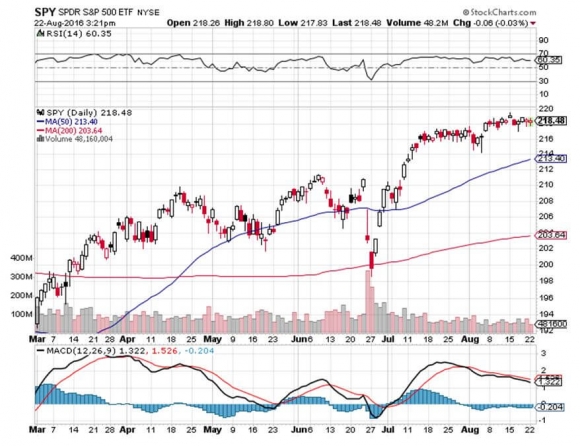Rise of the Quants
At almost every Global Strategy Luncheon I have hosted for the past decade, the same experience would replay itself.
Some kid would approach me with an algorithm driven trading program that was guaranteed to make money. It back tested perfectly and delivered spectacular returns.
Would I be willing to fund it for $1 million?
My answer was always the same: NO.
For a start, as a Math minor from UCLA, I never believed that the supplicants had the academic chops to accomplish such a feat. It all reeked of cherry picked data mining to me.
I know that big brokers like Morgan Stanley (MS) and Goldman Sachs (GS) deployed armies of Computer Science PhDs using $10 million mainframes attempting to accomplish the same thing.
Results were mixed at best.
Only the giant quant houses like Jim Simons? highly secretive Renaissance Technologies, LLC and DE Shaw have found the Holy Grail.
Finally, as a Marine combat pilot I can assure you that all machines eventually break. It is a certainty. This is what they drill into you at flight school. The only question is when.
When you?re betting your life on a machine, such a lesson leaves a deep imprint.
Just ask the shareholders of Knight Capital, who on August 1, 2012 saw their equity largely wiped out when a programming glitch enabled their computers to accidently lose $440 million in 30 minutes. A single line of errant code was the culprit.
However, I am starting to change my mind. At least this dog CAN learn new tricks.
The convincing factor has been the mysterious behavior of the major stock indexes over the past year, where traditional short-term market timing indicators have suddenly become useless.
Technical analysis has become a license to lose money, prompting adherents to buy every rally and sell each dip at great cost.
Just look at the market action of the past month, where you can hold a ruler over the charts and define a perfectly flat line. It is not a chart reflective of human interaction.
It?s as if all the traders were suddenly kidnapped and held hostage at an undisclosed location. I?ve never seen anything like it before.
Hedge funds are getting slaughtered, delivering their worst year in a 30-year history. As a result, a great washout in the industry is now underway. It may be the next industry to get totally disrupted.
As with all sea changes in market behavior, the reasons are legion.
A principal factor is the utter collapse of the cost of processing power. Super computers passed the processing power of the human brain in 2012.
It will improve a trillion fold by 2020, when such firepower will be available on a low-end laptop for only $2,000.
This means that entry-level technology budgets for these strategies will plunge from tens of millions to hundreds of dollars.
What happens when you get a several thousand fold drop in the cost of a technology? You get a lot more of it.
Enter social media and the sharing economy. All of a sudden, the tools needed to develop quantitative trading strategies are widely available, often for free.
Almost anyone can now access infinite amounts of data, again, for free. New big data programs make the analysis of this data easy.
Communities of programmers, mathematicians, and algorithmic traders are now sharing information in order to gain a competitive edge. Machine learning and artificial intelligence are joining the fray.
And while many hedge funds are still charging the traditional 2% and 20%, many quant managers don?t charge management fees at all. They?ll settle for a flat 20% of net profits, whatever those are.
The numbers are starting to impact the make up of the hedge fund community.
In 2009, some $407.7 million of $3 trillion in hedge fund assets was driven by quantitative strategies, according to Hedge Fund Research. Today, that figure has leapt to $878.7 billion, some 31.35% of the declining total.
At a time when the traditional hedge fund strategies are failing, some of the bolder firms are experimenting with the new technologies.
Steven Cohen?s Point 72 has committed up to $250 million in Quantopian?s start up crowdsourced hedge fund.
Numerai, a small San Francisco based hedge fund, is awarding prizes to ?the best trading programs submitted anonymously by data scientists.
Bridgewater Associates and Ken Griffin?s Citadel have hired advanced computing staff from IBM and Microsoft.
Other hedge funds are scouring Silicon Valley and the big universities for the talent to cobble together an in house effort.
Performance will ultimately determine which strategies will take us forward. So far the quants are winning.
Many algorithmic traders are showing decent profits in 2016. If conventional managers are up, they are lagging the 7% gain of the S&P 500.
And many are still down on the year in the wake of the meteoric six-month run in equities since February 9. Underweight managers have been chasing performance all year.
In the end, it is the investors who will determine the success or failure of quantitative algorithmic trading. Until now, it has remained a niche in which few individuals can participate.
It remains to be seen how much money the markets can absorb from the specialized, high technological approaches to the market, and whether the big pension funds can ever go near them.
A recurring flaw in many of these programs is the assumption of constant market liquidity which Long Term Capital Management proved to be a myth in 1998.
Still, who knows? Your next fund manager may be a Terminator.




